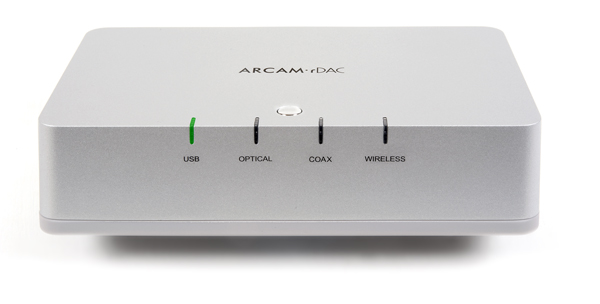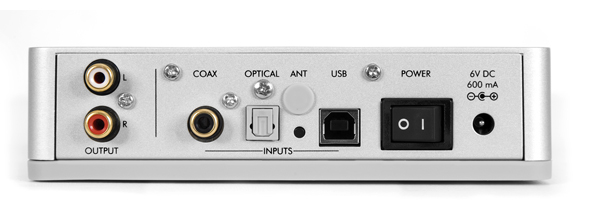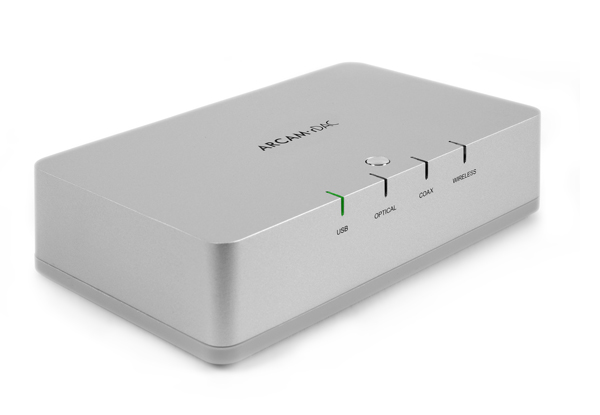Arcam rDAC DAC Pack
By Paul Rigby The concept behind a DAC is simple. It follows the same logic related to separating the pre and power stages of an amplifier to improve the latter’s overall sound quality. Isolating a DAC from its sister CD transport and connecting the two via a single cable should, in theory, enable each piece to work at its best as independent units. Such an arrangement eliminates the need of worrying about single-box downsides like electrical cross contamination and other associated distortions.
The concept behind a DAC is simple. It follows the same logic related to separating the pre and power stages of an amplifier to improve the latter’s overall sound quality. Isolating a DAC from its sister CD transport and connecting the two via a single cable should, in theory, enable each piece to work at its best as independent units. Such an arrangement eliminates the need of worrying about single-box downsides like electrical cross contamination and other associated distortions.
The technique also yields benefits in that a DAC can serve as a useful upgrade to a trusted CD player. In this setup, the user retains the original CD chassis, utilizes the transport, and plugs in the new DAC, effectively overriding the built-in DAC. In addition, a DAC can also plug into your computer, allowing you to take your PC as a serious digital source—possibly for the very first time. Great multi-taskers, DACs can enhance your audio-visual experience as well. Just attach a DAC to your DVD player or even a set-top box.
Arcam’s new rDAC is one such multi-purpose unit that, in this particular case, is the result of a unique partnership—and one in which a high-quality technological pedigree is instilled within.
“We’ve always had a strong partnership with dCS. Ten or 12 years ago, we built an integrated CD player with dCS, using the company’s Ring DAC technology, blown onto a single chip. We talked to them again about an USB-sourced DAC that dSC had developed. As a result, the rDAC has an asynchronous USB input which allows us to take control of the timing of the USB output of any PC device.”
So says Arcam Senior Engineer Andy Moore, who was tasked to tackle the horror source that is your basic computer. The problem is, your average PC system isn’t optimized for actual digital audio transfer.
“The PC tends to render audio over to the USB input,” confirms Moore, “goes off and does something else, realizes that the memory buffer is starting to run low, and then chucks another load of audio at the USB output—which results in all manner of jitter and timing errors. An asynchronous DAC takes control of it. Like a metronome, the asynchronous DAC says, ‘Give me data: now…now…now…now…’ You’re retiming the output of the PC, thus reducing the jitter errors to a factor of 50 to 100. The goal is to clean the data up before you turn the ones and zeroes into audio.”
Coaxial and optical inputs are also included on the rDAC, but the company recommends that, while fine for CD players and other external fittings, you do not plug your PC into the optical port, as doing so will trigger the return to audio chaos. Internally, the rDAC features a Wolfson WMA741 (the same as the Arcam’s top-of-the-line CD player), multiple staged regulation to provide a clean power supply, and a tidy layout for reduced cross-board interference. The front of the small cast-aluminium and largely inert chassis—spanning just 6.3 x 4 x1.6 inches and weighing only 1.5 pounds— features a row of source lights: USB, Optical, Coax, and Wireless (not actually available on this particular model). A rubberized, non-slip neoprene plate forms the chassis floor and acts as a deadening facility, reducing microphony.
The power supply, a “mere” wall-wart, has a “noise-rejection” supply, designed to reduce distortion. At first glance, this aspect could have been seen to be an obvious weakness to the overall design. But Moore is both re-assuring and slightly dismissive. “As it is, it wouldn’t have improved sound quality with the supply pushed back in the chassis and hooked up to a top quality power cable.”
My tests included a range of WAV lossless files ripped using the audiophile-friendly Exact Audio Copy software (www.exactaudiocopy.de). I listened via a Dual Core PC, running Windows Vista, with a trusted pair of Boss MA-12 active speakers. I inserted the rDAC between the MA-12s and the PC, with a USB plugged into the rDAC and the PC.
Playing Steve Jansen & Richard Barbieri’s “Ringing the Bell Backwards” from Stone To Flesh via the Arcam resulted in a dramatic widening of frequency bandwidth. Featured synthesisers, especially those with string emulations, came into true focus while the bass exhibited a newly rounded personality with accompanying power. The soundstage was wider and higher, augmented by a greater degree of instrumental separation that allowed the ear to concentrate on the detail rendered by each instrument.
When auditioning Carol Kidd’s “A Nightingale Sang In Berkeley Square” from Dreamsville, the PC’s midrange sans the rDAC was positively one-dimensional, claustrophobic, and restricted. Turning to the rDAC afforded the vocal performances a more emotional presentation, as acoustic guitar solos became more precise and incisive; cymbal-induced treble traits were now light as a feather. Moreover, the bass had room to move, allowing space to act as a melodic foundation.
Moving to my reference hi-fi and hooking up the well-received budget Cambridge Azur 650C CD player via the coaxial socket made immediately evident the Arcam’s fight against distortion. Although the Azur is a great value performer, the rDAC removed more distortion from the chain, resulting in a relaxed presentation that was easier on the ear—even on overly peak-limited CDs such as the Sugababes’ R&B-oriented Angels With Dirty Faces. Such greater degrees of focus allowed the performances additional chances to showcase their mettle. Bass sounded more natural, and upper mid and treble frequencies proved foot-tappingly musical.
Again and again, the rDAC found the heart and soul of jazz, as on the disc version of the Kidd album. Previously, pianos sounded relatively lifeless. Now, they skipped along like a smooth tap dancer. In addition, acoustic guitar solos had a real metallic edge and vocals served as a reminder that the human voice is made up of multiple parts and tones.
As a computer-related DAC, the Arcam box is a no-brainer. Utilizing dCS technology, it transforms USB-sourced data into a quality signal, providing computer users with a whole new sonic perspective. The rDAC also proves worthy in a hi-fi system. Hell, this little box would do wonders for your satellite box and DVD player, too. At this price, it’s a steal. The only question you need to ask is: “How many should I buy?”
Arcam rDAC
$479, €343
www.arcam.co.uk
Peripherals
| Digital Source | Cambridge Azure 650C |
| Preamplifier | Aesthetix Calypso |
| Amplifiers | Icon MB845 Monoblocks |
| Speakers | Boss MA-12 Quad ESL-57 (Slightly Modified) |
| Cables | Avid SCT Avid ASC |




